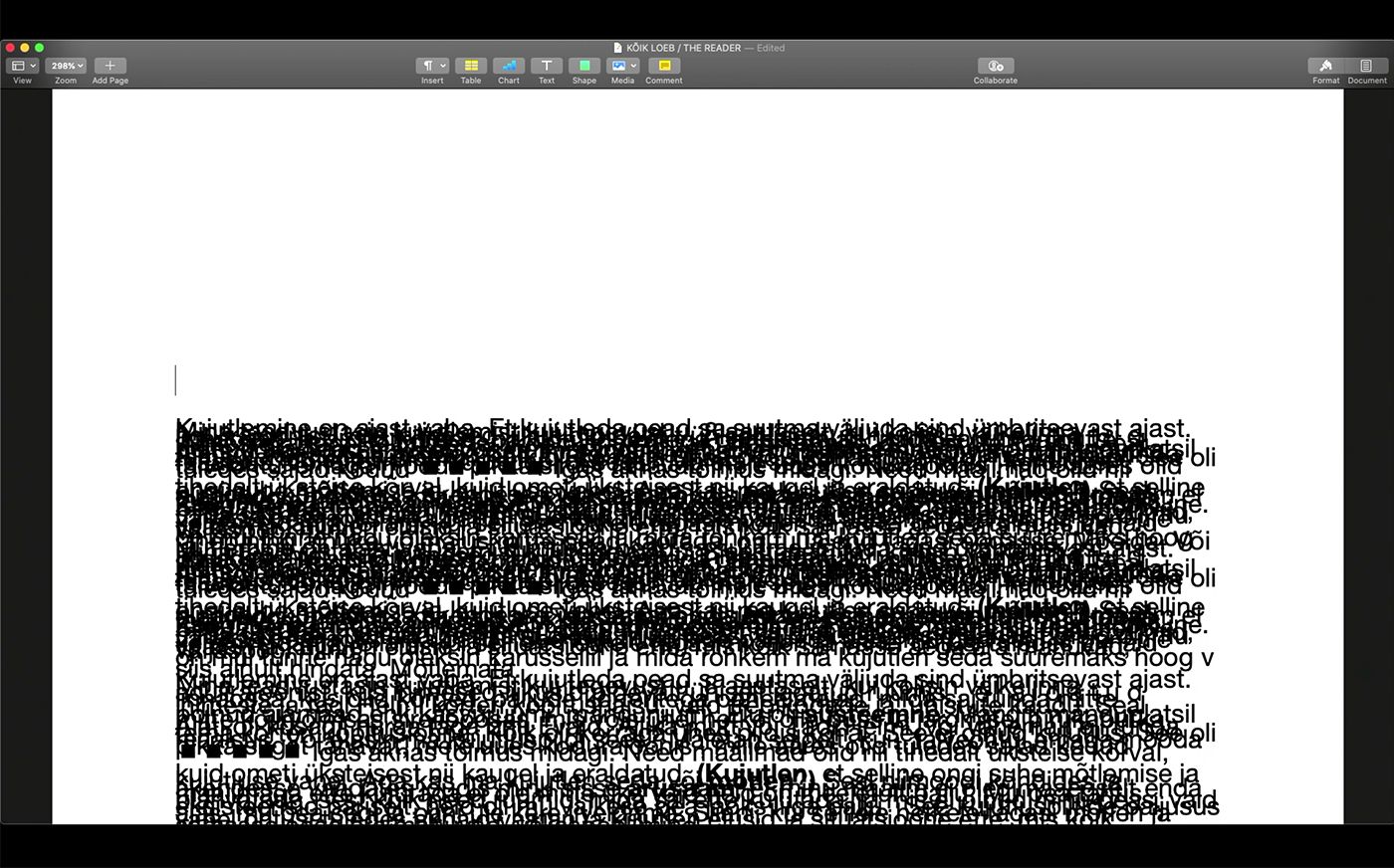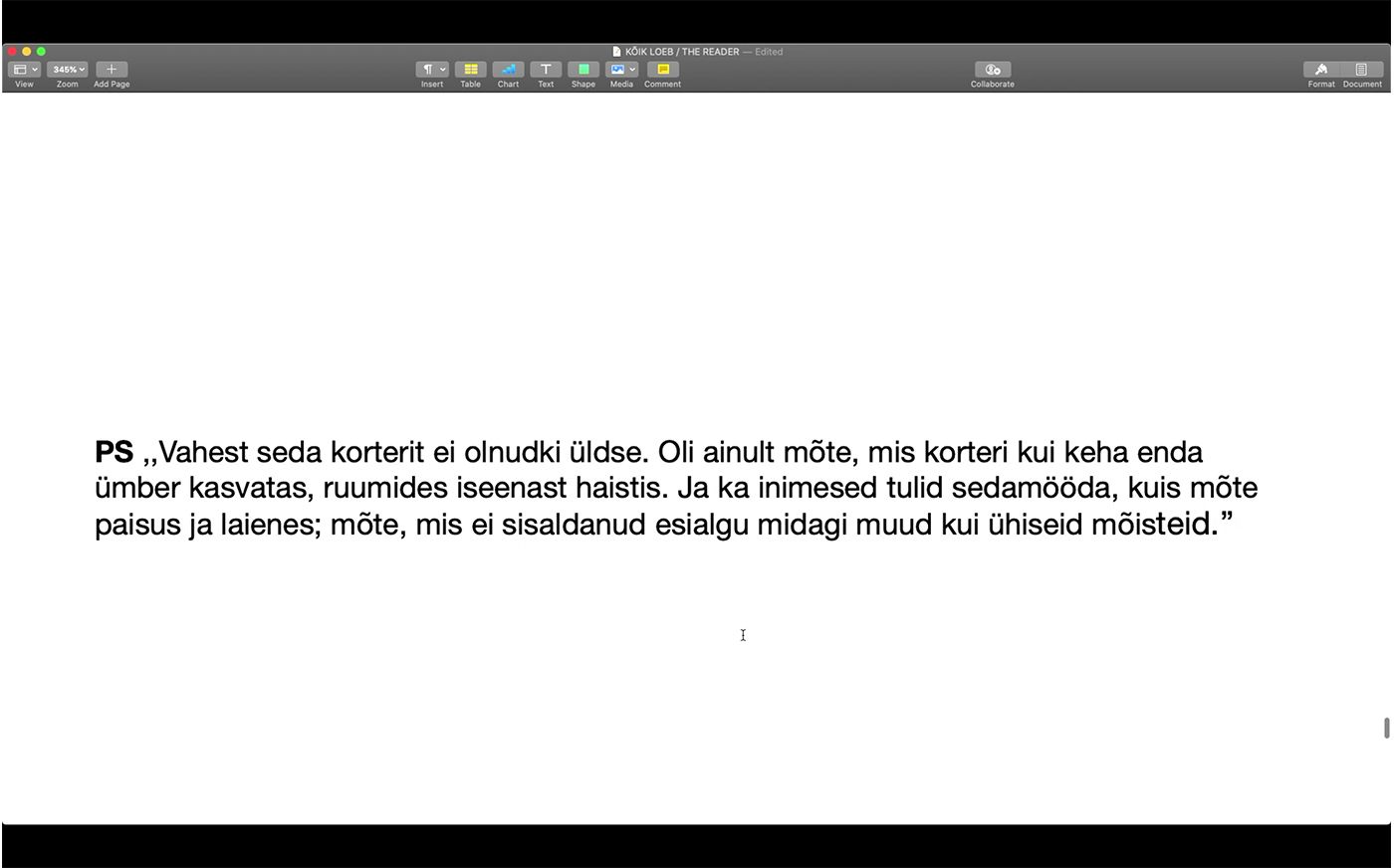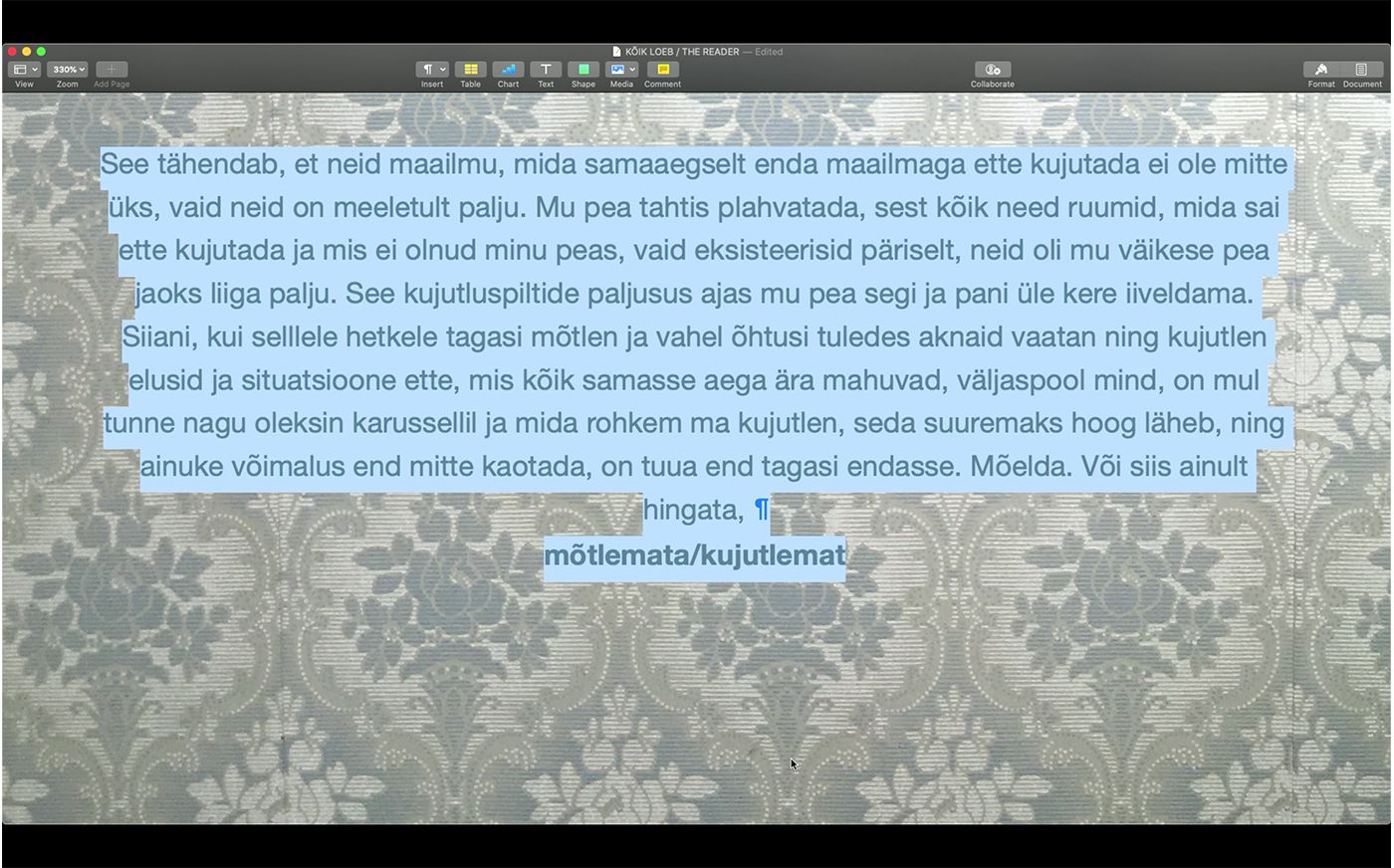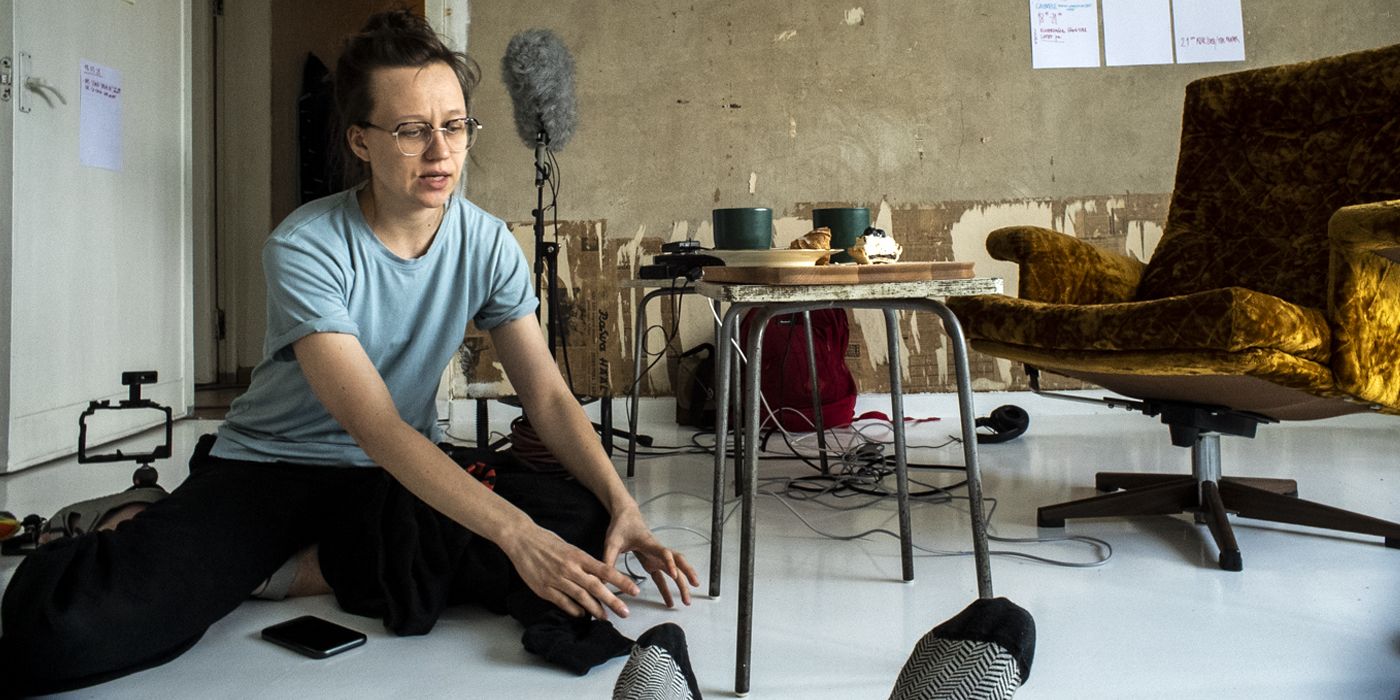
Magasin: How was your work “Kõik loeb / The Reader” born and what inspired you?
Liis Vares: The first impulse came from Taavet Jansen’s (artist name +aave+) album “the reader” (https://taavet.bandcamp.com/album/the-reader) which was created during the first coronavirus spring and conceived as a background for reading, for concentration. I was listening to it and got interested in the state I had while reading. In this distinctly invisible space the one occupies while reading: I am here and elsewhere at the same time; I am travelling far away in my imagination, although my physical body stays here.
When Taavet and I were presenting the album in the summer of 2020 at the “Kullaaugu Festival” organised by Argo Vals, I tried for the first time to read a book of my choice in a public space occupied by people accompanied by the same background sound. I was observing how and to where my attention was moving. Several interesting questions stemmed from that experience and the idea of an online format started to germinate.
Another source of inspiration was the philosophy lectures by Eik Hermann at the Estonian Academy of Arts (EKA). The course was meant to end with writing an essay. But what was even more important than the fair copy itself were the drafts - the process of how the initial idea was able to reshape itself via the writing. I chose the theme: “Imagination and thinking”. Is there a border between them somewhere? This was the question raised by Eik. I started thinking about it through writing. When the time for “Kõik loeb / The Reader” was approaching, then the essay I had written for Eik regained its relevance. The page that gets printed out during the show originates from the same essay. This is the border between imagination and thinking that I had come across.
Magasin: This piece is like stepping into a text or like physically entering a book, stepping into a page. Usually you work with your body, but where is your body while you are reading? One body enters the text while another one is sitting in the armchair?
Liis: The so-called visible body stays in the armchair, but my attention, a certain mobile part of me, enters the text. It is able to move in a much bigger scope than it is possible for the physical body. In the context of choreography, I have become more and more interested in how the attention moves and what is possible to do by moving the focus. Also in a direct manner on physical level, playing with it in an immediate way. In terms of dance the physical body (the external features) is often important: what we do with it, how we train it. Maybe there exists a possibility to step aside or to observe from aside, to not take so seriously the fleshly and physically appearing nature of ours. Sometimes I would like to think like that.
Magasin: One effect that the coronavirus era has created is us sitting in front of the screens while our attention is elsewhere. The body is sitting in one place while we watch a show or visit an exhibition somewhere else. Is there somehow more equality amongst bodies in the online environment? Does it liberate the body or instead suppress it?
Liis: There seems to be more equality amongst bodies, but I have the impression that people might not be ready to apply this freedom. Turns out that people (the audience) actually want that someone determines somehow their position. To bridle themselves is impossible, humans prefer what’s comfortable for them. The focus starts wandering, because of all the possibilities. There is the possibility to do many things at the same time. Let’s turn the computer on, let’s go see a show online, and then let’s make a sandwich. It is definitely not the fault of the online environment that people have difficulties receiving a performance or that the experience is not the same as in physical space. This is obvious. The person needs to make efforts to make the Internet work out well, to make sure that their personal technical skills are sufficient. For example, when going to the cinema or to see an exhibition or a theatre piece, I go there by myself, I do not expect the director to come and fetch me, or even to dress me etc. But when the audience HAS ARRIVED on their own, then it is the role of the artist, on one side of the screen or on the screen, to somehow activate the invisible and anonymous body on the other side. To do something that the spectator would sense that they are part of the activity, that they would start sensing their bodies. It’s a place of passivity with an enormous potential for activity. I am thinking that the “in-front-of-a-screen” situation may as well be a safe arrangement for waking up the spectators’ bodies in whole. People are at home - they could sing and dance if needed, do whatever and be completely present via their imagination.

Magasin: I didn’t at all get the feeling of going and making a coffee while watching “The Reader”. The dramaturgy was thrilling and the duration was exactly what could hold the spectator’s attention. I was having a flow of images. How did you come up with the order and length of the scenes? On what basis did you make the choices?
Liis: I think what worked was that my body was not visibly present. I appeared through another kind of media. Words and imagery allow you to imagine something more than just me. You can be more free. The space in the imagination of the spectator can be more vivid than my actual physical location. You as a spectator might sense yourself more thoroughly, because I am not there.
The dramaturgy came from going into the text, in collaboration with the word processor software Pages. Occasionally, I work at the bookshop Puänt, so I just got down to collecting books from the shelves there, googling words or imagery that had stuck to my head from a text. I reached for the books which were attracting my attention, flipped through them and found paragraphs that resonated with me. This was a way to collect paragraphs from texts and write down my own thoughts. Then back in my studio apartment I started to do the puzzle. I discovered shapes and functions in the Pages that led me back to the ideas or images I already had. I was trying to collaborate with the environments - to explore what the Pages had as functions and what the concrete physical space I was occupying could offer. What kind of associations and transmissions were emerging. For example in the text by Õnnepalu there is this wallpaper and I don’t even know anymore which came first the word or the wallpaper itself that I left on a wall in physical space. I tore it down from the rest of the walls, but it remained on one wall. I really liked that. And then I had the above mentioned paragraph and I realised that the wallpaper here and the text coincide. At some point I discovered in the Pages the function of directly taking a photo with my phone and inserting it into the text... This was the way the dramaturgy of space constructed itself in collaboration with intuitive logic. I didn’t use any other system.
Magasin: The exchange of energy between the performer and the spectator is crucial in performing arts. How does this function in a performance like that? Is it important for you to sense that someone is watching? Or it doesn’t matter and you are able to perform as if into a so-called black hole.
Liis: Yes, as a performer I don’t know how many people are watching: five people or one person or a hundred. But I still get stage fright. When in physical space you can cheat a bit, take something back or play it along, because no one knows how something was meant to work out. You are the one who knows best. The format for “Kõik loeb / The Reader” was so new to me that there was no previous experience or knowledge. It was a very intimate, but inhuman environment. The spectator was able to see every little move I made. I did have the sensation that there were people somewhere there. When I pushed the button “ON AIR”, then I couldn’t change anything anymore, then everything was transmitted to anyone.
At the same time, what I really like is that there is no energy exchange in the form of the venue being full of people who have arrived from I-don’t-know-which-place, someone is in a good mood, another one is in a bad mood, and thus the energy filling the space has nothing to do with the current show. As a performer you have no choice than to be in that energy, to receive it, to go somehow through it. This aspect is missing from the online environment. There is no such feeling that the audience should be in a particular way, should be very open and receptive in order for the performer to feel good about it. There is no such pressure when I am at home. I can be free the way I am, as a spectator as well as a performer.
It suited me as a performer that there was no immediate contact with the audience directly after the show. This part is quite difficult for me in physical space. I have difficulties socialising right after the show. Not because I don’t want to or that I don’t like it, but I would need a break for a night or a day. Then I could listen to and receive feedback, and have a discussion. When it’s an online performance, this part comes naturally with a delay. One moment you meet in the street with someone who has seen the show and they say that it was really great or that they didn’t understand it at all. And you hadn’t even known that they had been watching. This way the echoes last even longer or come as a surprise with a delay. It resembles the experience I have had with some of my published writings. Sometimes it takes years before someone says, “Hey, I read that and there was this interesting idea there” or “What did you mean by that?” Or I am reading someone’s final paper and find out that the author is quoting my idea, adding their comments to it. Assimilation is important.

Magasin: The reception of a text is very different from witnessing the performance in physical space. Here comes a very personal question, I heard that you were seriously ill while preparing for “Kõik loeb / The Reader”, you had the coronavirus. Did this and the isolation itself had an effect on the creative process?
Liis: I wasn’t at all seriously ill, I had a very mild case of coronavirus. But then again the mildness or seriousness is very relative to a person. I received the diagnosis exactly two weeks prior to “Kõik loeb / The Reader”. That is just when the intensive preparation period was supposed to start. The most significant effect of the coronavirus was the tremendous mental fatigue or the concentration difficulty. It made me even a bit panicky about having the strength to do nothing. I felt like I had to cancel everything. This filtered out everything that seemed too big of an effort. My focus became very sharp - to do only the essential things and as much as I could.
I thought of cancelling the performance, because I was not able to do it the way I had planned for. But thanks to the current coronavirus situation, it has become natural that no one knows what is going to happen tomorrow. Taavet suggested that we left the decision for the last day. So I just waited and saw. It was interesting, enjoyable, and the anxiousness disappeared. Otherwise there is always some tension: do I get ready, am I able to …, there is very little time left. That was all gone! My priority was to do as much as I could. One day I could think for half an hour, the other day for an hour, then it started to be too much. I had never done that before, so light-heartedly, completely carefree. And then there were the four intense days when Taavet and I went to Rakvere to set up the technical space and to rehearse together. I had pieces of text and ideas for the imagery. An idea of how everything might work out sound wise and visually. And then we just put it somehow together, like well this goes here, and then ran it through. That was it. We didn't even fully comprehend what it was. At first I felt a huge panic and then an immense lightness. From now on, I will try to do everything with such a vibe. Otherwise it is very difficult when you are at your full capacity; when there is nothing limiting you or pushing your focus to become clear. It was really awesome. I had never done anything like that, not in such a state.
Magasin: Could we say that the body was forcing you to take it into account. Is it easy to take physical capacities for granted when being well?
Liis: Yes, in the back of my head there is always the thought that I have to be occupied with it 24/7. More and more, still too little. It’s like that in my head. What is the amount of time, of activity, of time-out a process needs in order to reach its potential? It might not always be the more, the better. My body was somehow saying, “Wait, I cannot do more at the moment.” And then you start being in dialogue with yourself, doing as much as you are able to. Something great may be born in just two days' time. In our heads we have predefined processes about how pieces, exhibitions should be done - intense work during 3 months or a year. Always the same. I think people are different and actually it is possible to do things in every way. But people don’t dare, maybe don’t even know themselves and how they work best. How do I function best? Do I dare to make things my way?
Magasin: Let’s talk a bit about collaboration. How to collaborate in the field of dance or performing arts in a situation when it is not possible to get together? How has it been for you?
Liis: I had the experience of directing the creation process of “You Will Become a Dancer” (Sõltumatu Tantsu Laval) last spring. This was when the isolation life started. So it was that we couldn’t meet and it was a new situation for everyone. I went to the venue alone to do, to think, and to watch stuff. Meantime Katariina Unt was going there alone, recorded herself and left me clips to watch, then again Kristi Kongi was there painting the floor etc. At some point I went to the venue, looked at the space and thought the presence of a human being would be completely wrong there. The set design was there, the painting was there. All was good. The environment was really beautiful, why should a person enter this space. This was exactly what would ruin everything. It often is like that with the relationship between humans and environments.
It is always essential to me to be in sync with the circumstances. I cannot do collaborative work when people actually cannot meet. It doesn’t make sense to me. It feels wrong that we are still rehearsing, meeting up because we are so special, because theatre needs to be done, performances need to be done. Online-format seemed more appropriate. This is where we are right now, what this current time has to offer. It seemed a more honest place to be. But of course this is also limiting, the options with whom you collaborate are limited - with the closest people, the ones you can actually meet up with. But if you work in an online environment, then it’s not necessary to get together physically.
Magasin: You have been a dancer who has been improvising with different kinds of bodies and considering their different needs. Has working in distance somehow detached you from working with the body? You said earlier that you were looking at a space feeling that it was unnecessary to add a body in there. Has the body become a text or somehow virtual for you?
Liis: Currently, I really can’t see the point in doing things with the body in a physical space. It’s not primary to me. I am not really missing it in my artistic expression. I search for bodily expression in a different form, precisely that it would be transposed into other media. I have the impression that the physical body gets often in a way of an idea. If another body without a similar training or professional background is watching this body of mine, then there comes so many questions before reaching the idea that I actually want to deal with. And maybe I am not as much interested in the issues of dance art as a medium and of its history. The body interests me in a wider sense. I’m interested in people in this particular time in general. What it means to be in a body, in a human body, right now. Maybe some other media give more options to discover that area. At the same time, I need to say that, when I am thinking and being active artistically in this way, then it actually increases my interest in my own body. To deal with the body again and to search for answers from it. The detachment or the idea of detachment actually brings me anew to my body and allows me to do a restart. I’ll come back, when I have been away elsewhere.
Magasin: Will you be a dancer again?
Liis: Yes, something like that. I think maybe I have not yet become a dancer. I have always dreamt that maybe when I turn 80, then I’ll become a dancer; the kind who is somehow contemporary and able to reach other people. Up until then, I wouldn't know how and would have to search for it, but then suddenly I would be ready to create a solo that would resonate with many of my contemporaries.
